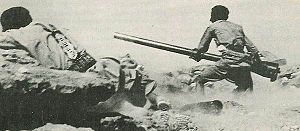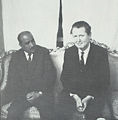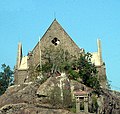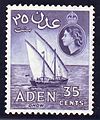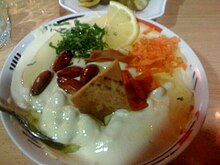Yemen Portal


Yemen (/ˈjɛmən/ ⓘ; Arabic: ٱلْيَمَنْ, romanized: al-Yaman), officially the Republic of Yemen, is a country in West Asia. It is located in the southern end of the Arabian Peninsula, bordering Saudi Arabia to the north and Oman to the northeast. It shares maritime borders with Eritrea, Djibouti and Somalia. Covering 530,000 square kilometres[dubious ] (204,634 square miles) and having a coastline of approximately 2,000 kilometres (1,200 miles), Yemen is the second-largest Arab sovereign state on the Arabian Peninsula. Sanaa is its constitutionally stated capital and largest city. The country's population is estimated to be 34.7 million as of 2023. Yemen is a member of the Arab League, the United Nations, the Non-Aligned Movement and the Organisation of Islamic Cooperation.
In ancient times, Yemen was the home of the Sabaeans, a trading state that included parts of modern-day Ethiopia and Eritrea. Later in 275 AD, the Himyarite Kingdom was influenced by Judaism. Christianity arrived in the fourth century, and Islam spread rapidly in the seventh century, with Yemenite troops playing a crucial role in early Islamic conquests. Various dynasties emerged between the 9th and 16th centuries. During the 19th century, the country was divided between the Ottoman and British empires. After World War I, the Mutawakkilite Kingdom of Yemen was established, which became the Yemen Arab Republic (North Yemen) in 1962 following a coup. South Yemen became independent in 1967. In 1990, the two Yemeni states united to form the modern Republic of Yemen (al-Jumhūrīyah al-Yamanīyah). Ali Abdullah Saleh was the first president of the new republic until his resignation in 2012 in the wake of the Arab Spring.
Since 2011, Yemen has been facing a political crisis, marked by street protests against poverty, unemployment, corruption, and President Saleh's plan to amend Yemen's constitution and eliminate the presidential term limit. Subsequently, the country has been engulfed in a civil war with multiple entities vying for governance, including the government of President Hadi (later the Presidential Leadership Council), the Houthi movement's Supreme Political Council, and the separatist Southern Movement's Southern Transitional Council. This ongoing conflict has led to a severe humanitarian crisis and received widespread criticism for its devastating impact on Yemen's people. (Full article...)
Selected article -
The North Yemen Civil War (Arabic: ثورة 26 سبتمبر, romanized: Thawra 26 Sabtambar, lit. '26 September Revolution') was a civil war fought in North Yemen from 1962 to 1970 between partisans of the Mutawakkilite Kingdom and supporters of the Yemen Arab Republic. The war began with a coup d'état carried out in 1962 by revolutionary republicans led by the army under the command of Abdullah as-Sallal. He dethroned the newly crowned King and Imam Muhammad al-Badr and declared Yemen a republic under his presidency. His government abolished slavery in Yemen. The Imam escaped to the Saudi Arabian border where he rallied popular support from northern Shia tribes to retake power, and the conflict escalated rapidly to a full-scale civil war.
On the royalist side, Jordan, Saudi Arabia, and Israel supplied military aid, and Britain gave covert support. The republicans were supported by Egypt (then formally known as the United Arab Republic) and were supplied warplanes from the Soviet Union. (Full article...)List of selected articles
|
|---|
Selected biography -
Yahya Muhammad Hamid ed-Din (or Imam Yahya) (Arabic: يحيى محمد حميد الدين, 18 June 1869 – 17 February 1948) was the first king of the Mutawakkilite Kingdom of Yemen from 1918 until his assassination in 1948. He became Imam of the Zaydis in 1904 after the death of his father, Muhammad Al-Mansur, and Imam of Yemen in 1918. His name and title in full was "His majesty Amir al-Mumenin al-Mutawakkil 'Ala Allah Rab ul-Alamin Imam Yahya bin al-Mansur Bi'llah Muhammad Hamidaddin, Imam and Commander of the Faithful" (the prince of the believers, he who relies on God, the Lord of the Universe).
Yahya Muhammad Hamid ed-Din was born on Friday 18 June 1869 in Sanaa into the Hamidaddin branch of the al-Qasimi dynasty who ruled most of Yemen proper and the southern region of present-day Saudi Arabia for over 900 years. When Yahya became Imam, he effectively ruled over the mountainous areas of what will be North Yemen. However, the Ottomans who made claims in the area did not recognize the rule of the Imams of Yemen since their entry into the region. He spent the early years of his reign attempting to expel the Ottoman presence, who withdrew after their defeat in World War I. (Full article...)List of selected biographies
|
|---|
General images -
Selected city -
Thula (Arabic: ثُلَاء, romanized: Thulāʾ) or Thila (Arabic: ثِلَاء, romanized: Thilāʾ) is a town in west-central Yemen. It is located in the 'Amran Governorate.
Thula is one of five towns in Yemen on the UNESCO World Heritage Tentative List. Dating to the Himyarite period, the town is very well preserved and includes traditional houses and mosques. Archaeological investigation discovered Sabaean period ruins with massive stone architecture beneath the Himyarite. Restoration between 2004 and 2011, restored the Bab al Mayah gate, several
watch towers, paths, the traditional cistern, and other portions of the Sabaean fort. (Full article...)Selected picture -
Selected cuisines, dishes and foods -
List of articles
|
|---|
Related portals
Religions in Yemen
Arab states
Categories
Topics
Related portals
Religions in Yemen
Arab states
Associated Wikimedia
The following Wikimedia Foundation sister projects provide more on this subject:
-
Commons
Free media repository -
Wikibooks
Free textbooks and manuals -
Wikidata
Free knowledge base -
Wikinews
Free-content news -
Wikiquote
Collection of quotations -
Wikisource
Free-content library -
Wikiversity
Free learning tools -
Wiktionary
Dictionary and thesaurus
